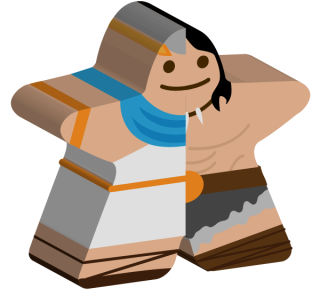In the first post in this series, I described 4 (rounding up from 3.5) tribes of game designers, each tribe with a core value system that its members shared. Of course, like any categorisation, these tribes are somewhat arbitrary and necessarily forced, but I find putting things in boxes helpful, as it brings clarity to both the box and the thing you’re putting in it. This post, I’m going to take the concepts of the tribes and mix them together, not just because the real world doesn’t neatly fit into the 4 discrete boxes, but because this will actually be helpful. We’ll find that some tribes share values that interact harmoniously and that designers taking ideas from both of those tribes can create some really fantastic games, but other tribes have values that are mutually exclusive and that trying to design while adhering to the beliefs of both tribes can lead to troubled development and a troubled final design. Personally, I often find myself at the dark crossroads between two of these opposing tribes and thinking about this has definitely given me some clarity, and I hope this post will help you come to terms with your own game design tribal identity.
Last post, I was happy to have my proposal that there weren’t really any iconoclasts in board game design refuted in the comments, and I’d love to hear about some great games that totally refute my points below. Action Points Aaron also pointed out these tribal terms already exist in game theory, and while those terms in a game theory context definitely help describe these tribes they may not be 100% in line with the way I’m using the words, as I’ve imported them directly from Scott McCloud’s discussion of comics and other non-interactive media (so they’ve been metaphorically google translated a few times).
Quick Recap
Just so we’re back on the same page, here’s a quick statement of the core beliefs of each tribe.
Animist: games should be immersive experiences that tell stories.
Classicist: games should be intellectual experiences, rewarding players for strategic thinking.
Formalist: games should push the boundaries of what games are; if it’s been done before, it’s boring.
Iconoclast: authenticity above all else! Games should actually try to reflect reality rather than letting players escape from it.
Animist + Classicist
 The animist tribe has a natural affinity with classicist ideals, using the mastery of craft to best express themes, and even classicists feel the draw of storytelling and channel their inner animist to create games that are strategic but also evoke (or at least logically represent) a certain theme. I identified Fantasy Flight Games as animist last week, but the development of many of their games is firmly supported by the craft of classicists, more specifically games with ongoing development, such as X-Wing and Netrunner.
The animist tribe has a natural affinity with classicist ideals, using the mastery of craft to best express themes, and even classicists feel the draw of storytelling and channel their inner animist to create games that are strategic but also evoke (or at least logically represent) a certain theme. I identified Fantasy Flight Games as animist last week, but the development of many of their games is firmly supported by the craft of classicists, more specifically games with ongoing development, such as X-Wing and Netrunner.
Match: Yes!
Formalist + Iconoclast
![]() Formalist and iconoclast designers both seek to step outside traditional boundaries and push the medium to explore new ideas, in stories and mechanisms. Brenda Romero created a game called Train that seems to take from both these tribes. It is a little confronting, so I’m not going to talk about it in this post. You can read more about it here (there are spoilers, but it’s pretty unlikely that you’ll get a chance to play the game).
Formalist and iconoclast designers both seek to step outside traditional boundaries and push the medium to explore new ideas, in stories and mechanisms. Brenda Romero created a game called Train that seems to take from both these tribes. It is a little confronting, so I’m not going to talk about it in this post. You can read more about it here (there are spoilers, but it’s pretty unlikely that you’ll get a chance to play the game).
Match: Yes!
Animist and Iconoclast
![]() Both these tribes care about theme, just in different ways. The animist tribe strives to create an immersive experience no matter what the story, and the iconoclast is very strongly focused on the theme itself, yearning to create a game that is authentic in its representation. The only real conflict here is the complete lack of conflict, neither tribe really cares about game mechanisms and that could result in a game that lacks player agency.
Both these tribes care about theme, just in different ways. The animist tribe strives to create an immersive experience no matter what the story, and the iconoclast is very strongly focused on the theme itself, yearning to create a game that is authentic in its representation. The only real conflict here is the complete lack of conflict, neither tribe really cares about game mechanisms and that could result in a game that lacks player agency.
Match: Yes, but consider inviting another tribe along!
Formalist and classicist
 The formalists and classicists are both focused on the mechanisms of games, often abandoning both the animist and iconoclast desire for representation. There’s an obvious interplay between the two schools as ideas are created by the formalists and then refined by the classicists. Donald X. Vaccarino arguably invented the deck building genre of games with Dominion (a game often mocked for its lack of theme), which has been refined by many other designers. Many of Vaccarino’s other games, such as Kingdom Builder, show a more classicist lean, but he’s clearly not afraid to experiment and push new boundaries in true formalist style.
The formalists and classicists are both focused on the mechanisms of games, often abandoning both the animist and iconoclast desire for representation. There’s an obvious interplay between the two schools as ideas are created by the formalists and then refined by the classicists. Donald X. Vaccarino arguably invented the deck building genre of games with Dominion (a game often mocked for its lack of theme), which has been refined by many other designers. Many of Vaccarino’s other games, such as Kingdom Builder, show a more classicist lean, but he’s clearly not afraid to experiment and push new boundaries in true formalist style.
Match: Oh yeah!
Classicist and Iconoclast
![]() There can be a conflict between classicist and iconoclast ideals, with the former trying to create a perfect game, and the latter believing that it is the message, not the medium that’s important. We can look to Cards Against Humanity as a true iconoclast game (with maybe some animist influence) that would be worse off with a more classicist influence; the simple game system lets the true horribleness of the game and the people playing stand out. There is potential to find a neutral ground here, creating a well-crafted game in a classicist style, but taking more thematic inspiration from the iconoclasts. In the comments from last post, Phil Eklund was put forward as an iconoclast and it seems his games sit fairly comfortable at the intersection of the iconoclast and classicist tribes.
There can be a conflict between classicist and iconoclast ideals, with the former trying to create a perfect game, and the latter believing that it is the message, not the medium that’s important. We can look to Cards Against Humanity as a true iconoclast game (with maybe some animist influence) that would be worse off with a more classicist influence; the simple game system lets the true horribleness of the game and the people playing stand out. There is potential to find a neutral ground here, creating a well-crafted game in a classicist style, but taking more thematic inspiration from the iconoclasts. In the comments from last post, Phil Eklund was put forward as an iconoclast and it seems his games sit fairly comfortable at the intersection of the iconoclast and classicist tribes.
Match: Exercise caution
Animist and Formalist
![]() There is a less obvious, but more dangerous conflict between animist and formalist beliefs. A true animist needs to focus on the theme of a game, immersing players in a specific world, and the formalist desire for innovation disrupts that immersion. Hanabi, an example of truly formalist game, is very loosely about creating a fireworks display, but the game does little to actually evoke that theme. While the original Dungeons and Dragons was very innovative for its time, the current developers of the world’s most popular role-playing game are very much adherents to the classicist tribe as opposed the formalist. The 5th edition of the game uses the iconic d20 system and it’s innovations do very little to upset the boat, borrowing from other role playing games that forged the path forward, allowing players and dungeon masters to focus on the story, not the mechanics.
There is a less obvious, but more dangerous conflict between animist and formalist beliefs. A true animist needs to focus on the theme of a game, immersing players in a specific world, and the formalist desire for innovation disrupts that immersion. Hanabi, an example of truly formalist game, is very loosely about creating a fireworks display, but the game does little to actually evoke that theme. While the original Dungeons and Dragons was very innovative for its time, the current developers of the world’s most popular role-playing game are very much adherents to the classicist tribe as opposed the formalist. The 5th edition of the game uses the iconic d20 system and it’s innovations do very little to upset the boat, borrowing from other role playing games that forged the path forward, allowing players and dungeon masters to focus on the story, not the mechanics.
Match: Exercise caution
Post-tribal
Next time, I’ll explore what a post-tribal world looks like (spoiler: you’re living in it) and delve into my own inner tribal conflict. Also, I know there wasn’t actually any game designer tribal warfare in this post, but it sure made for a better title that Designers in Boxes. In the meantime, be a box troll and tell me how I wrong I am in the comments.
One thought on Game designer tribal warfare
Comments are closed.
I think I am mostly in the Animist+Classicist camp, but am trying to add more Formalist to the mix.